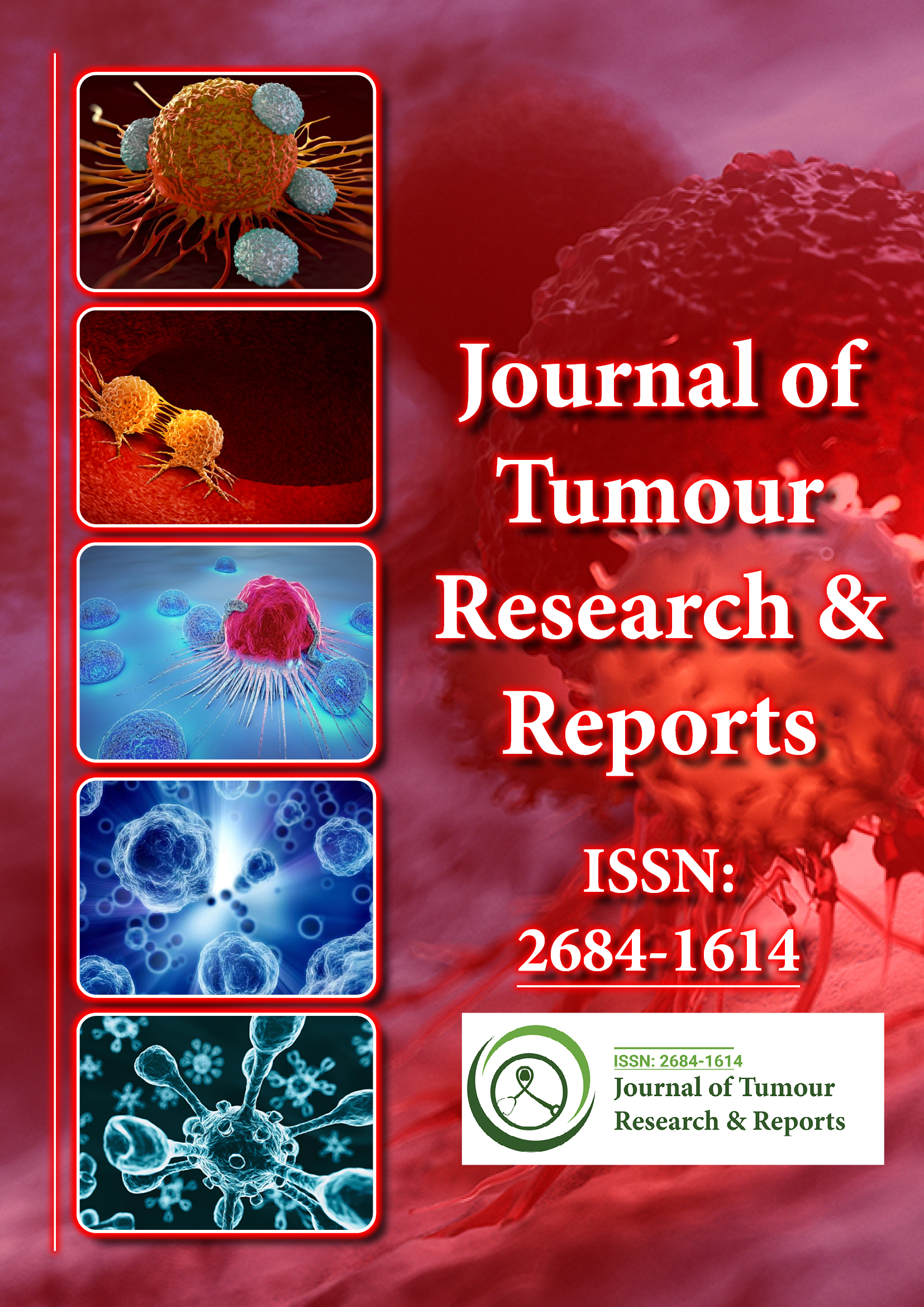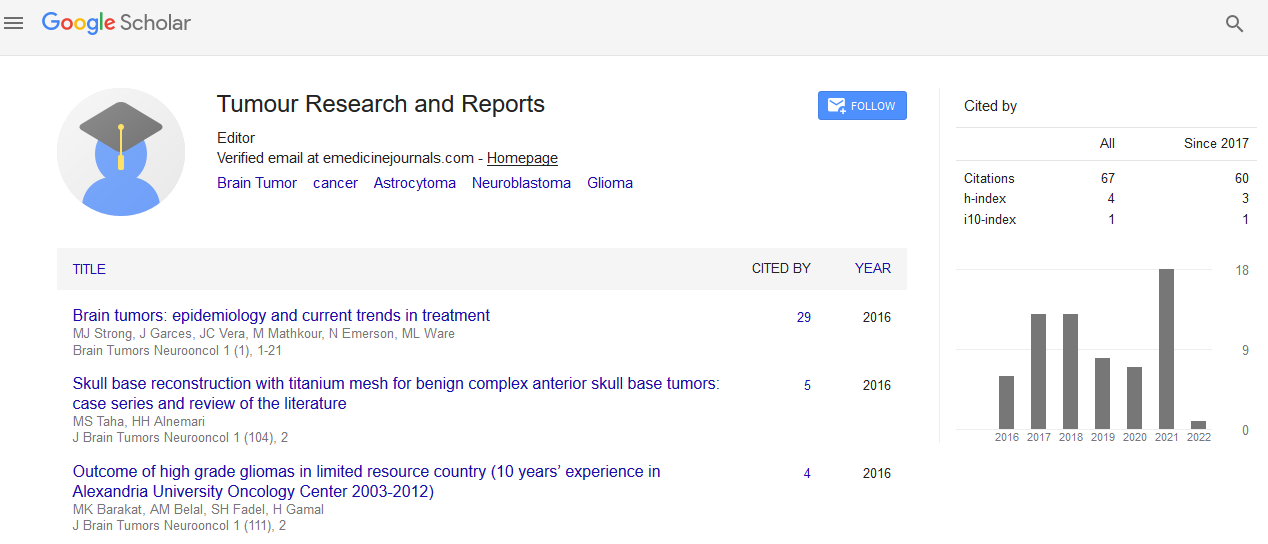Indexed In
- RefSeek
- Hamdard University
- EBSCO A-Z
- Google Scholar
Useful Links
Share This Page
Journal Flyer

Open Access Journals
- Agri and Aquaculture
- Biochemistry
- Bioinformatics & Systems Biology
- Business & Management
- Chemistry
- Clinical Sciences
- Engineering
- Food & Nutrition
- General Science
- Genetics & Molecular Biology
- Immunology & Microbiology
- Medical Sciences
- Neuroscience & Psychology
- Nursing & Health Care
- Pharmaceutical Sciences
Opinion Article - (2025) Volume 10, Issue 1
Liquid Biopsy as a Tool for Early Cancer Detection: Current Status and Future Study
Emiliano Vargas*Received: 03-Mar-2025, Manuscript No. JTRR-25-29017; Editor assigned: 05-Mar-2025, Pre QC No. JTRR-25-29017 (PQ); Reviewed: 19-Mar-2025, QC No. JTRR-25-29017; Revised: 26-Mar-2025, Manuscript No. JTRR-25-29017 (R); Published: 02-Apr-2025, DOI: 10.35248/2684-1614.25.10.248
Description
Cancer diagnosis traditionally relies on tissue biopsies, imaging techniques, and histopathological evaluation. While these methods are often effective, they are invasive, limited in frequency, and sometimes fail to capture the full heterogeneity of a tumor, particularly in metastatic settings. In recent years, liquid biopsy has emerged as a revolutionary, minimally invasive diagnostic tool that holds the potential to transform cancer detection, monitoring, and personalized therapy. Liquid biopsy involves the analysis of tumor-derived materials such as Circulating Tumor Cells (CTCs), Circulating Tumor DNA (ctDNA), Extracellular Vesicles (EVs), and other biomarkers present in body fluids like blood, urine, saliva, and cerebrospinal fluid. Among these, plasma-derived ctDNA has gained the most clinical attention due to its ability to reflect tumor-specific genetic alterations in real time.
The utility of liquid biopsy spans a wide spectrum of oncologic applications. One of its most promising uses is early cancer detection. As tumors grow, they shed fragments of DNA into the bloodstream, some of which carry mutations, methylation patterns, or chromosomal rearrangements characteristic of cancer. Detecting these alterations in ctDNA can enable identification of tumors at a stage when curative treatment is more feasible. Multiple large-scale studies have demonstrated that ctDNA can be detected in early-stage lung, breast, colorectal, and pancreatic cancers, although sensitivity varies depending on tumor type, size, and vascularization.
Early detection through liquid biopsy also shows promise in populations at high risk for certain cancers. For example, individuals with a familial predisposition to colorectal or pancreatic cancer can benefit from regular liquid biopsy testing to monitor for ctDNA mutations such as KRAS, APC, or TP53. Likewise, patients with chronic viral infections or inflammatory conditions that predispose to hepatocellular carcinoma or gastric cancer could be monitored for specific epigenetic or mutational changes. Several commercial tests are now under clinical validation or in use, such as the multi-cancer detection platform Galleri, which uses methylation signatures to detect over 50 types of cancer from a single blood draw.
Liquid biopsy offers not only early diagnosis but also the opportunity for real-time monitoring of disease progression and treatment response. Serial sampling enables clinicians to track changes in tumor burden and detect emerging resistance mutations, facilitating timely therapeutic adjustments. In lung cancer, for instance, EGFR mutations such as T790M that confer resistance to first-line tyrosine kinase inhibitors can be detected in ctDNA, guiding the switch to third-generation agents like osimertinib.
Despite its promise, there are significant challenges to implementing liquid biopsy for early detection on a global scale. One of the main limitations is the sensitivity of ctDNA assays, especially in early-stage disease where the concentration of tumor-derived DNA is exceedingly low. Advances in next-generation sequencing (NGS), digital droplet PCR, and methylation-based detection have significantly improved sensitivity and specificity, but further refinement is needed to avoid false positives and negatives.
Tumor heterogeneity also complicates the interpretation of liquid biopsy results. A single blood sample may not capture all relevant subclonal mutations, and the ctDNA profile may differ from that of the primary tumor or metastatic sites. This makes comprehensive genomic profiling difficult, especially when precise molecular information is needed to guide targeted therapy. Additionally, the presence of clonal hematopoiesis age-related mutations in hematopoietic stem cells can lead to the detection of non-tumor-derived mutations, potentially confounding clinical interpretation.
Standardization of pre-analytical and analytical workflows is another critical issue. Factors such as blood collection methods, processing time, storage conditions, and DNA extraction protocols can significantly impact the quality and quantity of ctDNA obtained. Moreover, bioinformatics pipelines for interpreting sequencing data vary across laboratories, leading to discrepancies in mutation detection and classification. Regulatory bodies and professional organizations are actively working toward harmonizing these protocols to ensure consistency and reliability.
From an economic perspective, liquid biopsy has the potential to reduce healthcare costs by enabling earlier diagnosis and less reliance on invasive procedures. However, initial setup costs, the expense of high-sensitivity assays, and limited insurance reimbursement remain barriers to widespread adoption. Cost-effectiveness analyses and real-world outcome data will be critical in persuading payers and policymakers of its long-term benefits.
Citation: Vargas E (2025). Liquid Biopsy as a Tool for Early Cancer Detection: Current Status and Future Study. J Tum Res Reports. 10:248.
Copyright: © 2025 Vargas E. This is an open-access article distributed under the terms of the Creative Commons Attribution License, which permits unrestricted use, distribution, and reproduction in any medium, provided the original author and source are credited.

